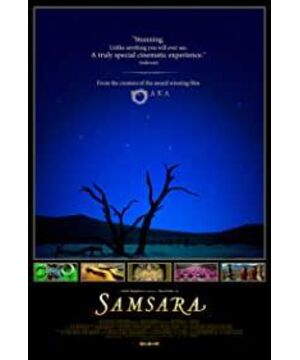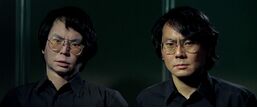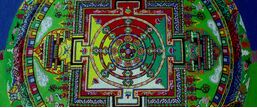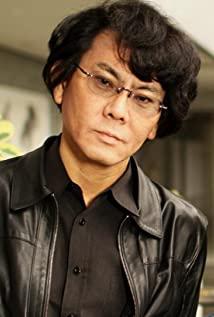Hurricanes and dust storms, stars move, thousands of lights are on, the moon sets and the sun rises.
Between the stars and sunsets, every frame of the natural landscape in the lens and the bustling city stretching thousands of miles are extremely shocking.
For thousands of years, from the tribes living in the primitive society to the rows of streets and the speeding trams, the modernization achievements of human civilization are placed in front of my eyes.
How to imagine that thousands of years of numbers fly by, and tall buildings rise from the ground?
After the hurricane and sandstorm, dilapidated houses, libraries, and classrooms were buried by dust and sand, leaving no one inhabited.
You see, the overturning of buildings and civilizations for thousands of years only takes a moment.
In the nearly 90-minute screen, it only takes a few seconds to tell me:
"All you see is dust."
Just like the mandala paintings painted by the lamas at the beginning, the ending is also dispelled and the dust goes into the sea.
In the documentaries "Mandala Sand Painting" and "The Third Pole", it is mentioned that the sand paintings painted by the lamas are a mandala, which is the residence of the gods, and reaching the mandala to bow down to the gods is the heart of the lamas. Towards. The whole process of painting a mandala takes a long time, including sand making from scraps, composition, and sand laying.
As you can see in the video, the guru divides the mandala in two with a vajra, and radiates it in eight directions from the center. Sand in a few special locations is bottled and distributed to lamas who make mandala or enshrined, while other fine sand is fed into rivers and returned to the sea.
Every carefully carved mandala will be dispelled.
In Buddhism, there is always such freedom.
Reincarnation I, in the end why.
Whether it is the mandala paintings in Tibetan Buddhism, or the "emptiness" in Chinese Buddhism, they all have their own wisdom.
The Diamond Sutra says: All appearances are false.
The arrival of a new life, the end of life, how it has gone through, only it knows.
Most people, like social clocks, are on a set path and live a life that is expected.
The social clock as a view of cultural determinism, proposed by Neugarten and Hejstad in 1976, argues that not only does culture determine how people should behave, but those culturally expected and approved behaviors also affect people's behavior. Be a part of an individual in a specific chronological order throughout one's life.
Just like pigs and chickens in a farm; like parts of a factory, according to the steps of assembly line production, formatted and formulated, predictably, step by step, step into the next process until the end.
You fluidly control the fate of the chicken
The social clock has fluidly grasped you.
But in the rapidly developing social torrent, people's primitive desires are concealed.
French performance artist Olivier uses paint, clay, and exaggerated body language to reveal the animal nature of human beings. In the film, he is sitting in the office and tying his bow tie. He is neatly dressed and he is in a state of madness, forming a very ironic contrast.
Harmony, Civility, and Etiquette.
Lust, savagery, and bestiality.
The shemale's numb eyes could not hold a tear from a geisha.
Reincarnation I, in the end why.
At the end of the film, the Thousand-handed Avalokitesvara looks up, as if dancing in the desert
In the blink of an eye, the sand filled the sky.
Maybe thousands of years later, the crystallization of human beings will be hidden in the desert.
Looking down from the universe, the grand achievements of civilization are but a grain of sand
Only for a moment.
View more about Samsara reviews











